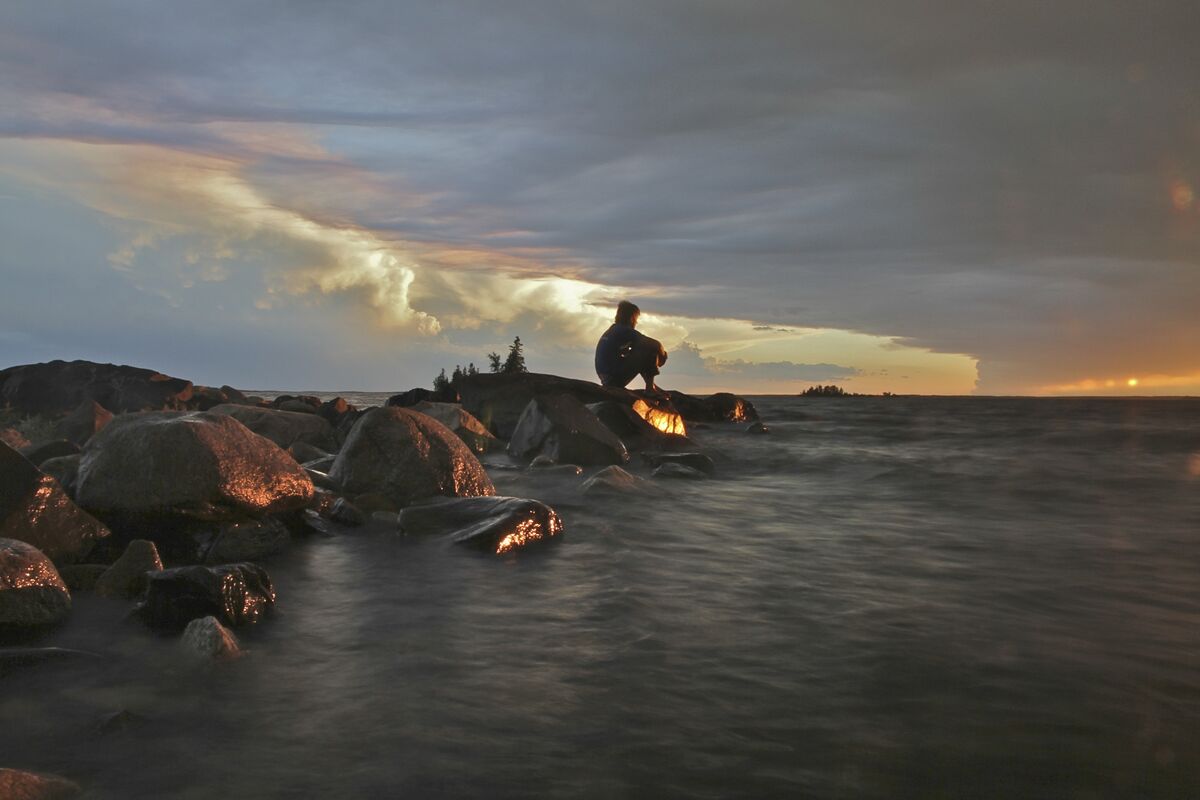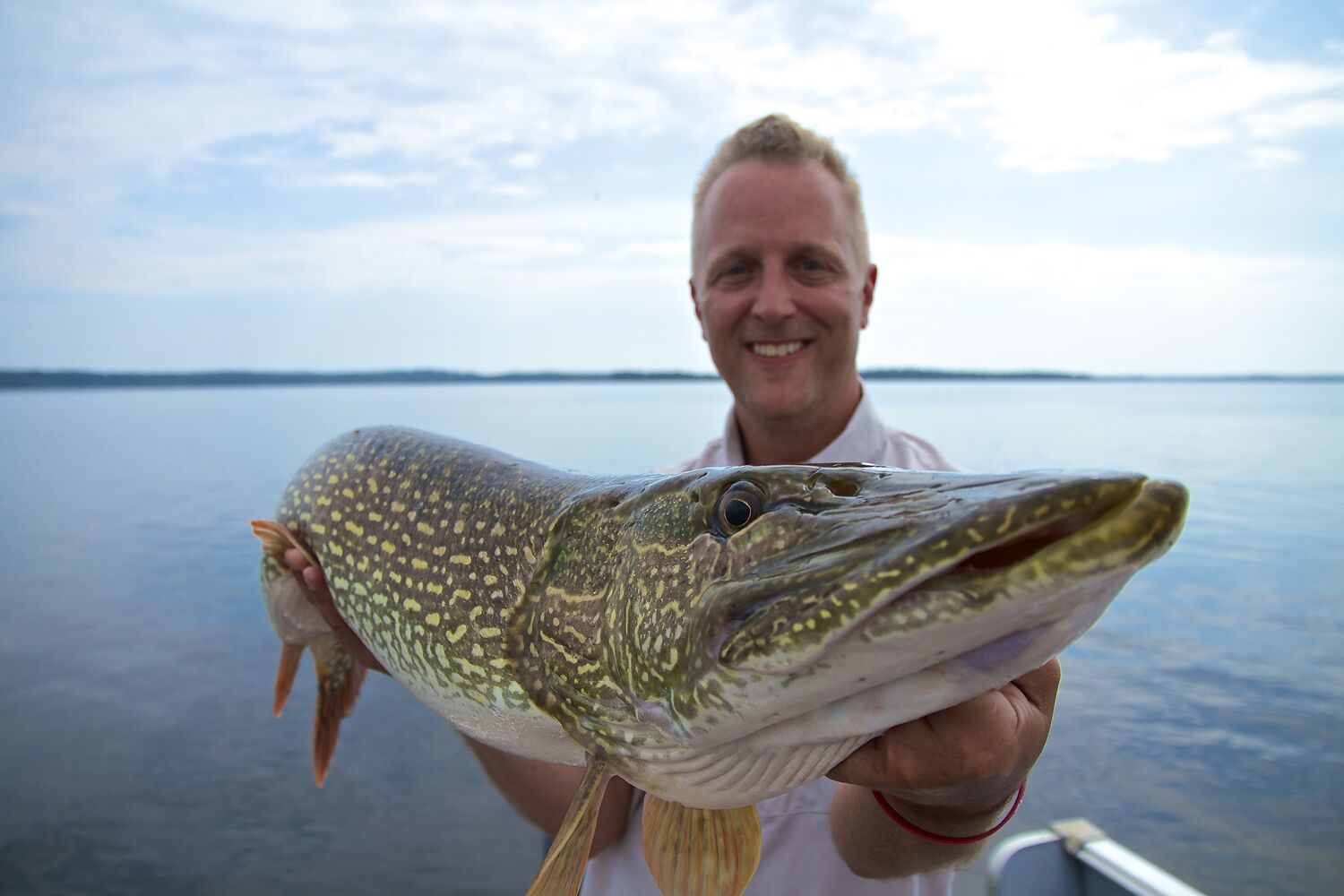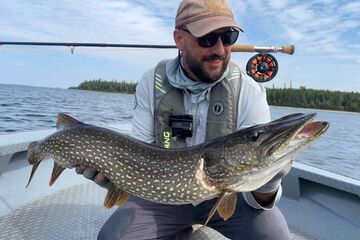Esox Lucius: The Water Wolf
It is difficult to say what exactly goes into making a trophy pike fishery. However, one old fishing adage comes to mind, “Big water produces big fish.” When it comes to big water, Sunset Country has you covered. Lac Seul, Lake of the Woods, Lake Nipigon and Rainy Lake are all massive bodies of water. They hold high in the ranks as some of Canada’s most famous and fabled fisheries. Lake St. Joseph, located in the heart of Sunset Country at the end of Highway 599, is perhaps lesser known but is no less worthy of accolades. This unique, remote, and pristine fishery is home to monsters and a lot of them.
In the angler’s vernacular, there are many nicknames for northern pike, including simply “northern” or “pike.” Ironically, few actually refer to the fish’s Latin name, Esox Lucius, literally, water wolf. Many of the nicknames are demeaning in nature. Snake, slimmer, snot rocket, hammer handle, ditch shark…it goes on. The last name, ditch shark, speaks to the species’ resiliency and survival ability in marginal waters. Indeed, northern pike have an absolutely massive native range that spans nearly the entire northern hemisphere. Although a global fish, true trophy northern pike fisheries are relatively uncommon. Few lakes and rivers hold trophy specimens. Even fewer hold more than the odd lunker. If you want to narrow your odds of catching a true gator, head to Sunset Country. Even better, head to Lake St. Joseph.
Lake St. Joseph: Sunset Country’s Hidden Gem
At 92 miles (148km) long with a surface area of 190 square miles (493 square km), Lake St. Joe is a winding maze of bays, islands, and points. Lake St. Joseph, however, was not always a lake. In the 1930s, a hydro dam was constructed at the lake's northeastern end to supply electricity to the newly flourishing Pickle Crow gold mine. Three other dams, one more on the east end and two more on the west end, were eventually constructed, fully controlling the in and outflow of the lake. While hydro generation was relatively short-lived on the lake itself, Lake St. Joseph remains a vital reservoir for Lac Seul and the major power generating station located in Ear Falls. For over 90 years, Lake St. Joe has helped provide clean, renewable energy to Ontario’s north.
 Taking in the beauty of Lake St. Joe
Taking in the beauty of Lake St. Joe
Generally speaking, the damming of rivers and waterways has a negative effect on fish populations. Lake St. Joseph might be an exception to the rule. After the dams were constructed, the water levels on Lake St. Joseph rose anywhere from 8–12 feet. As a result, acres upon acres of swampland, marsh, bog, and muskeg were flooded and incorporated into the lake itself. It is likely that some areas of the lake that appear as major bays today were actually once their own lakes, connected by marsh and creeks. The flooding of Lake St. Joe unlocked seemingly limitless new spawning and habitat opportunities for aquatic species of all kinds.
Walleye and Northern Pike are the two and only game fish species of note on Lake St. Joseph. It does hold perch, but they are stunted and rarely get bigger than a half dozen inches. Whitefish are abundant in the lake but are not often targeted. In addition to a healthy population of suckers, ciscos, a freshwater herring, are found in huge numbers on the lake. All these fish species, sport fish and forage alike, use the flooded areas of Lake St. Joseph as spawning habitats, nurseries, and lunch windows. However, the species that arguably benefited the most is not a fish at all but an invertebrate.
Every year, Lake St. Joseph is home to an absolutely massive mayfly hatch. By mid-June, the lake has warmed up enough to allow hatches to begin in secluded, muck bottom bays. For the next month to month and a half, the mayfly slowly moves from the shallows of bay backs to main-lake rock piles. Biologist and former guide at the Old Post, Ayden Ricker-Held, established the importance of mayfly larvae to the diet of walleye on Lake St. Joseph in his 2019 study supported by the Old Post Lodge. It is only reasonable to assume that the giant populations of stunted perch, whitefish, and ciscos also benefit greatly from the mayfly hatch. The sheer size and duration of the hatch ensures these fish have a seemingly endless forage base on which to feast. While mayflies are not a significant part of a northern pike’s diet, they are for everything a pike likes to eat. As a result, Lake St. Joseph is overloaded with food for pike. This allows them to not only grow big but also plentiful.
Fishing for trophy northern pike on Lake St. Joseph
The Lake St. Joseph Accord
With a seemingly endless forage base, acre upon acre of prime spawning habitat, and over ninety miles of open water to hunt, it is no wonder Lake St. Joseph has such a healthy population of trophy-sized northern pike. However, overharvest and poor management can quickly ruin even the best fishery. This is something that the local lodge owners realized shortly after starting operations in the mid to late 1980s. It does not take a genius to realize that stringers full of forty-plus in pike can not last forever, but it does take incredible foresight and determination to do something about it. By the early 1990s, a coalition of lodge owners, local residents, First Nation members, and the Ministry of Natural Resources worked together to create a set of special regulations for the lake. The regulations, called the Lake St. Joseph Accord, are still in place today. They help preserve, maintain, and potentially even improve upon the world-class fishery that Lake St. Joseph offers.
First and foremost, non-residents require a special Lake St. Joseph fishing tag (a small sticker on the back of your license). The tags can only be obtained from a lodge operator and are produced in a limited number yearly. Furthermore, non-residents are not allowed to camp within 0.6 miles (1 km) from the shore of Lake St. Joseph. Not only does this limit the amount of fishing pressure the lake sees every year, but it also means that non-residents who want to fish the lake have to put money into the local economy by staying with an outfitter.
Other regulations have also been implemented to ensure the health and long-term sustainability of the fishery. To help protect against the introduction of invasive species, smelt is not allowed to be used for bait. The most forward-thinking regulation, one that has had a significant impact on the health of the fishery, was instituting a single, barbless hook rule. While one treble counts as a single barbless hook, this regulation has eliminated the use of baits with two, three, or even four treble hooks that can cause serious harm and mortality to fish. It also happens to be much safer for the angler! I have personally had the opportunity to take both a barbed and barbless hook out of my body. Both hurt. Both are unwelcome. But one is certainly worse and can sometimes mean a trip to the emergency room and the end of fishing for the day. With the exception of some fly-fishing trout waters in Southern Ontario, part of the Nipigon system, and a few others, Lake St. Joseph continues to be one of the few fisheries in Ontario that is completely barbless.
Put ‘em Back Alive: Benefits of a Catch and Release Fishery
In addition to the legal regulations that were put in place by the Ministry of Natural Resources, the lodges on Lake St. Joseph also bounded together to institute an unofficial but strictly followed rule of the lake: NO POSSESSION ON TROPHY FISH! While the Ministry regulations allow for possession of one oversized fish, lodges do not allow northern pike over 27 inches (69 cm) and walleye over 18 inches (46 cm) to be harvested. Mature, spawning-age fish that are caught on Lake St. Joseph go back into the lake safe and sound to swim another day. Simply put, catch and release works. Over the course of two summers, a very identifiable one-eyed, half-tailed trophy pike the fishing guide staff at Old Post Lodge affectionately named Stumpy was caught four times! From the exact same spot, no less.
Not only does putting trophy fish back into a lake allow for that fish to be caught again, and again, and again, and again (just like Stumpy), but it also keeps important genetic material in the system. Trophy fish, and pike in particular, produce more and more eggs the bigger they get. A mature female pike is able to produce upwards of 9000 eggs per pound of fish. A trophy female pike got big for a reason. Whatever that reason is, it should be passed on to its offspring. Catch and release practices help protect and maintain the genetic health of a fishery.
Simply put, the more trophy fish put back into a system, the more trophy fish that system can produce. On the contrary, when trophy fish are removed from a fishery, it throws the trophic balance of an aquatic system into disarray, causing long-lasting consequences for the ecosystem as a whole. These changes are often difficult, if not impossible, to reverse. Once trophy fish are gone, it is hard to get them back.
The End of the Road
One of the final factors that helped create a world-class pike fishery on Lake St. Joseph is simple geography. Located approximately 25 miles (40km) south of Pickle Lake, Ontario, Lake St. Joseph is about as remote as you can get in the province while still travelling on a provincial highway. This puts the lake in a sort of “Goldilocks zone” - far enough south to have a decently long growing season and far enough north to keep the water cool in hot summer months. Its distance from civilization and small local populations also limits the amount of fishing pressure the lake sees in any given season.
Getting to Lake St. Joseph is still relatively easy, especially if you don’t mind a drive. From Toronto, you can travel along either section of the Trans-Canada Highway. If you choose Highway 17, you are blessed with breathtaking views of the water and tall, rugged hills along Lake Superior's north shore. Taking the north route along Highway 11 is highly underrated. The drive is flat and straight, making it much more relaxing to navigate than the hilly and winding Highway 17, and it provides the driver with absolutely spectacular views. People say the Prairies are flat, but the stretch of Northern Ontario between Cochrane and Long Lac barely has a hill. The board-flat landscape makes for incredible and seemingly endless vistas, especially beside a lake around sunset and sunrise.
Highways 17 and 11 merge together again just outside of Nipigon, and a couple of hours west of Thunder Bay, you make the turn onto Highway 599, the final frontier in Ontario. Five or six more hours of driving, depending on construction, and you have arrived at the Lake St. Joseph landing. The landing is located 40 km south of Pickle Lake and is accessible by the public. Americans who drive almost always cross at International Falls. From there, it is another seven or so hours to the landing on Lake St. Joseph. Pickle Lake has an airport that can accommodate private flights. The Old Post Lodge, operating on Lake St. Joseph since 1987, also charters flights direct from Goderich, Ontario.
Despite its size and pristine fishery, only five lodges operate on the lake. The largest of which is Old Post Lodge. It is also the only lodge to offer American Plan and has a full-time professional guide staff. This helps guarantee you will have a comfy and productive stay after putting in all the long hours in your vehicle getting there. While the drive is certainly not short, it is absolutely worth it. Lake St. Joseph is one of the few places in Ontario that offers the experience, fishing quality, and seclusion of fly-in fishing that you can drive to. As a result, it has some of the best odds of hooking a gator you can find just about anywhere in the world.
Happy Fishing!


